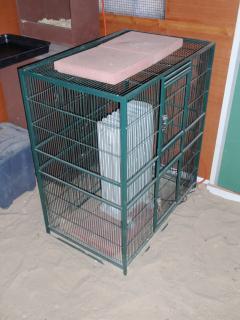I'd be interested in their suggestions for a more secure set-up.
Definitely it sometimes is necessarily in life to run a lamp, and the general program you describe (attach it by two different points on the lamp to two different points on the coop in a sturdy way) is certainly the beginning of a safe setup (well, as safe possible anyhow, nothing in life is totally guaranteed safe, certainly not heatlamps
 )
)
What you (WoodlandWoman) have doubtless done as well, but which many people neglect or knowingly cheat on (and sometimes get to meet their local firefighters over), is to make sure the guard is on the lamp to reduce chances of chicken impact and so that if it *should* fall it won't lie directly flat on the floor; carefully obey the required clearances IN ALL DIRECTIONS between lamp and combustibles (with high wattage lamps this can mean having it 18" above any bedding and at least as far from any walls or ceilings or brooder lids; use as low a wattage as possible (often just plain lightbulbs are quite adequate, especially if you've got everything set up intelligently); in some circumstances, you can use two half-wattage bulbs rather than one high-wattage one, to give the same total watts of heat with less fire hazard; and of course as soon as you don't absolutely HAVE to have that lamp on anymore, turn the lamp off and remove it.
Really there are an awful lot of design features that can greatly reduce the wattage one needs to be running (sometimes to 'less', sometimes to 'not use lamp at all'). I wish people would do them more often. (Directed at the world in general, not WW in particular
 )
)
Pat
Definitely it sometimes is necessarily in life to run a lamp, and the general program you describe (attach it by two different points on the lamp to two different points on the coop in a sturdy way) is certainly the beginning of a safe setup (well, as safe possible anyhow, nothing in life is totally guaranteed safe, certainly not heatlamps

What you (WoodlandWoman) have doubtless done as well, but which many people neglect or knowingly cheat on (and sometimes get to meet their local firefighters over), is to make sure the guard is on the lamp to reduce chances of chicken impact and so that if it *should* fall it won't lie directly flat on the floor; carefully obey the required clearances IN ALL DIRECTIONS between lamp and combustibles (with high wattage lamps this can mean having it 18" above any bedding and at least as far from any walls or ceilings or brooder lids; use as low a wattage as possible (often just plain lightbulbs are quite adequate, especially if you've got everything set up intelligently); in some circumstances, you can use two half-wattage bulbs rather than one high-wattage one, to give the same total watts of heat with less fire hazard; and of course as soon as you don't absolutely HAVE to have that lamp on anymore, turn the lamp off and remove it.
Really there are an awful lot of design features that can greatly reduce the wattage one needs to be running (sometimes to 'less', sometimes to 'not use lamp at all'). I wish people would do them more often. (Directed at the world in general, not WW in particular

Pat




